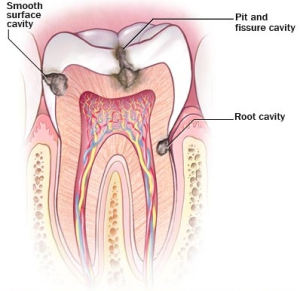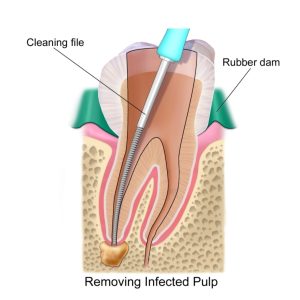WHAT IS A ROOT CANAL?
To understand what is a Root canal , let us know whats inside our teeth. Our teeth are covered outside by a hard white layer called ENAMEL , then semi -soft layer called DENTIN, and then a fully soft PULP . Once a tooth gets infected by caries, then how much deeper the layer is infected , that decides whether we just need a filling or we need to clean both the top and root portion of the teeth , that pulp also gets infected, which is called the Root canal Treatment.
A root canal treatment is a dental procedure to remove inflamed or infected pulp on the inside of the tooth which is then carefully cleaned and disinfected, then filled and sealed.
Root canal treatment is designed to eliminate bacteria from the infected root canal, prevent reinfection of the tooth and save the natural tooth.


How does endodontic treatment save the tooth?
It’s necessary to have endodontic or root canal treatment when the inside of your tooth (the pulp) becomes inflamed or infected as a result of deep decay, repeated dental procedures, faulty crowns or a crack or chip in the tooth. Trauma to your tooth may also cause pulp damage even if the tooth has no visible chips or cracks. If pulp inflammation or infection is left untreated, in can cause pain or lead to an abscess.
When you undergo a root canal or other endodontic treatment, the inflamed or infected pulp is removed and the inside of the tooth is carefully cleaned and disinfected, then filled and sealed with a rubber-like material called gutta-percha. Afterwards, the tooth is restored with a crown or filling for protection and will continue to function like any other tooth.
Endodontic treatment helps you maintain your natural smile, continue eating the foods you love and limits the need for ongoing dental work. With proper care, most teeth that have had root canal treatment can last a lifetime.
Root Canal vs Extraction
When the nerve of a tooth becomes irreversibly damaged or infected, you have two main options: root canal treatment or extraction. Both procedures prevent the spread of infection and pain, but they are quite different in how they go about it.
Root canal, or endodontic therapy, is a procedure that involves removing the diseased pulp from inside your tooth, cleaning and disinfecting it, then filling and sealing it. This helps to save the natural tooth structure while providing relief from any pain or discomfort caused by infection. The major advantage of a root canal is that it preserves the existing natural tooth and avoids extensive and costly restorative treatment (such as a bridge or implant) to replace it.
An extraction is just what it sounds like: the complete removal of a tooth and its periodontal attachment from its bony socket. While extraction effectively eliminates pain and infection, there are marked downsides to consider:
The first is that you will need to fill in the missing space in order to maintain proper alignment of your bite. Spaces left by extracted teeth can cause other teeth to shift, affecting your ability to properly chew and impacting your smile. The replacement of the missing tooth will require additional visits, possibly with multiple dental specialties, and potentially other dental procedures (bone grafts, sinus lifts, etc.).
Secondly, an extraction can be more costly than an endodontic procedure followed by a single tooth restoration. When presented with both options of Root Canal vs Extraction, more often than not, opting for a root canal will be less expensive and allow you to keep your tooth. Nothing looks, feels or functions like a natural tooth.
Finally, an extraction is a larger procedure and often is more uncomfortable than a root canal.
Book a consultation
If you would like to know more about this or any of our treatments and find out if they are right for you, Fill the Form below to book a consultation or make

